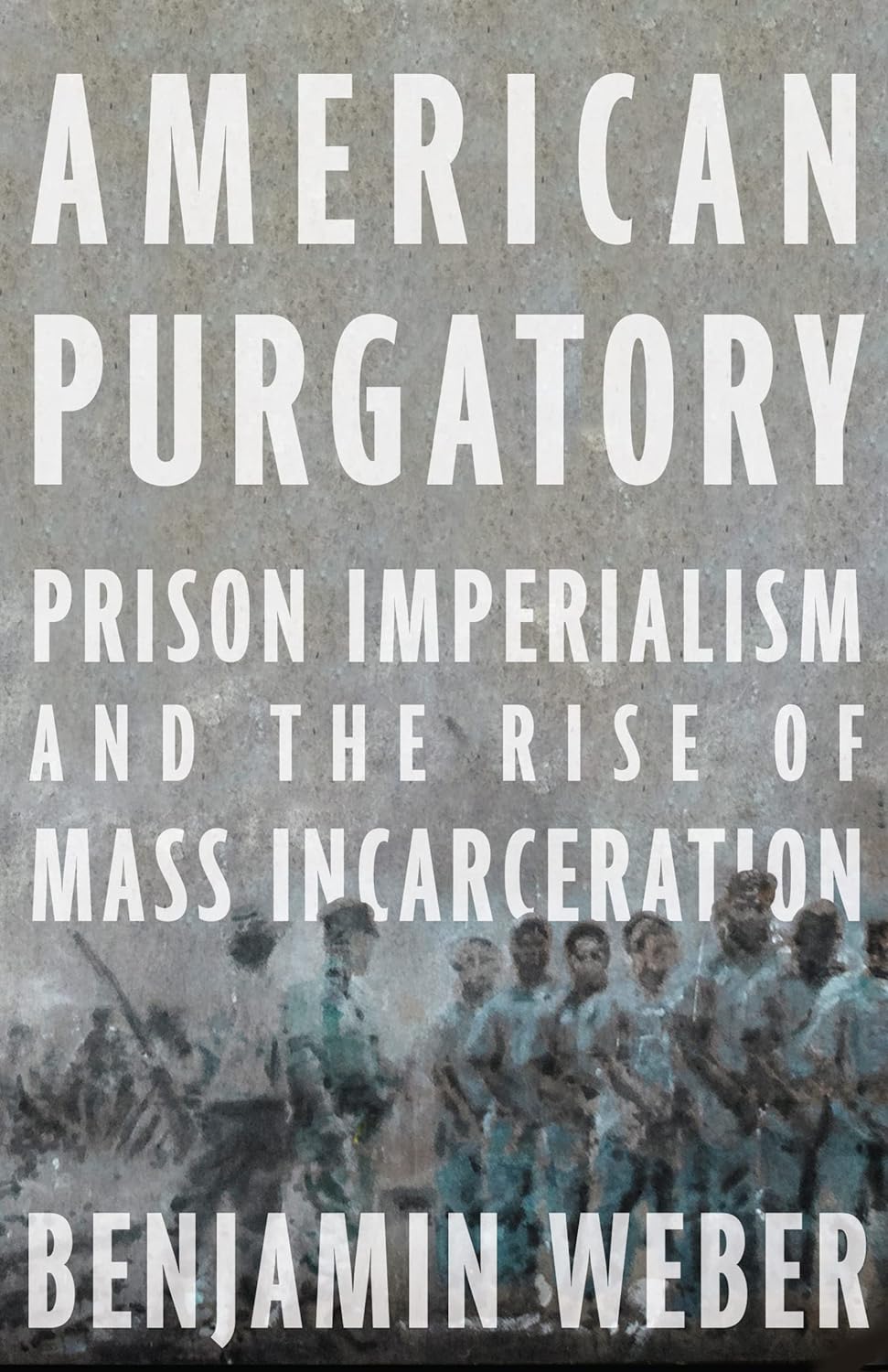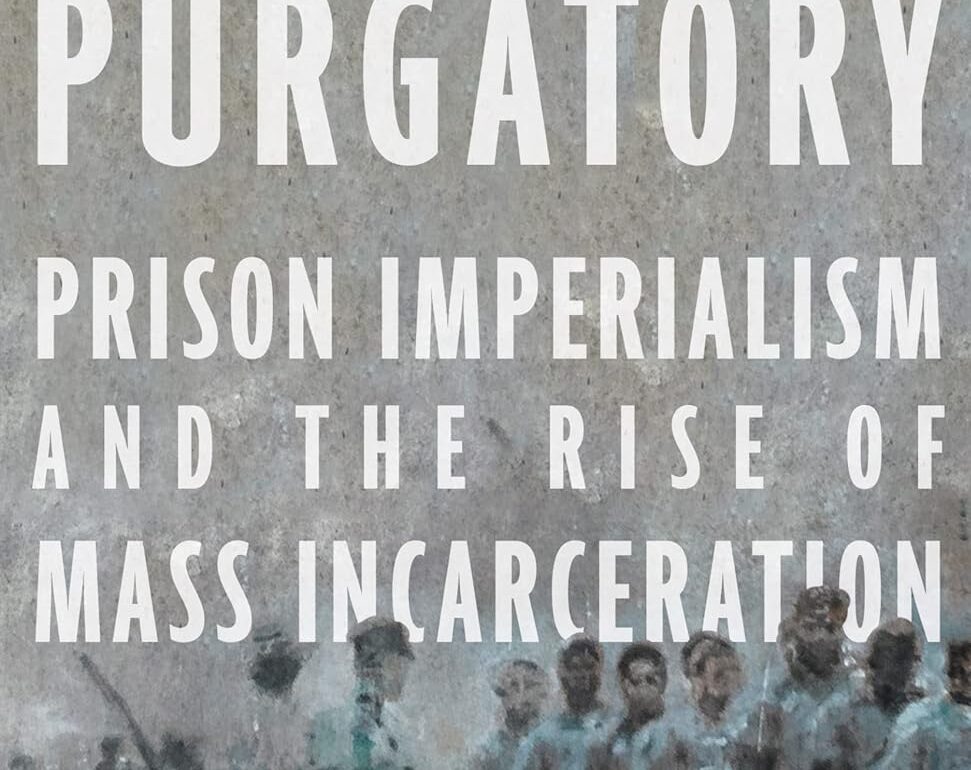
DANTE PUT PURGATORY on the other side of the world. The intermediate space between Heaven and Hell, where the not-quite-irredeemably wicked expiate their guilt, Purgatory is the second stop on Dante’s guided tour of the afterlife in the Divine Comedy, and he imagined it as a mountain, a sort of rugged stairway to Heaven, climbed by means of suffering. He placed this mountain on an island in the Southern Hemisphere, a world away from his native Florence. Purgatorio begins with the poet clambering out of Hell, to gaze upon “four stars not seen before except by the first people.” And yet, turning his eyes, Dante can also see stars he knows, stars we all know—the constellation he calls the “Wain,” what we call the “Big Dipper,” Ursa Major.
Benjamin D. Weber’s new book American Purgatory: Prison Imperialism and the Rise of Mass Incarceration imparts just such a double vision, a capacity to see the near and the far at once, to recognize that, even at the ends of the Earth, we have never left home entirely behind us. Weber is assistant professor of African American and African studies at the University of California, Davis, as well as an experienced public historian, policy researcher, and activist. The book is a history of the American prison as it sprawled through and beyond the United States, from Thomas Jefferson and James Madison’s fantasies of an offshore penal colony to the global reach of contemporary “e-carceration” (think ankle monitors, offender registries, and other technologies that control without the need for a prison). American Purgatory seeks to unite the history of the prison, the history of slavery, and the history of American empire, arguing that they are bound together by carceral violence and by the resistance to it. The climb out of the American purgatory is at least as steep as Dante’s mountain, with no guarantee of reaching Paradise. But we have Weber’s book, a more comprehensive map than any yet made, with paths upward marked out by those whose knowledge was earned by hard experience.
Medicine Water, a chief of the Southern Cheyenne, spent four torturous years in American purgatory as a prisoner at Fort Marion in St. Augustine, Florida. He was captured in 1874 after more than a decade of armed resistance to the United States’ imperial ambitions. For the rest of his life after his release, his legs bore the scars of the shackles. “This,” he would say, “is what the government did to us to get control of our land, buffalo, ways of life as a people, and take away our freedom as Cheyennes.” The prison had been a weapon of the imperial project, and Medicine Water knew it.
Fort Marion was already 200 years old in 1874, founded by the Spanish as the Castillo de San Marcos in 1672. “America Begins Here,” declares the National Park Service—a rather telling statement, that America began with a fortress, albeit the oldest such in the continental United States. Built with enslaved African and Indigenous labor, to protect the commerce of the Spanish Empire, the fort became, as Weber writes, “one of the first cornerstones of U.S. prison imperialism, part of a network of historical and contemporary black sites that reveal the colonial roots and global dimensions of the U.S. carceral state.”
A “black site,” in the modern lexicon, means Abu Ghraib, Bagram Air Base, Guantanamo Bay—those non-places where prisoners who are not “prisoners” are imprisoned and where things that never happened take place. Approaching Fort Marion, or Alcatraz, or Iwahig Penal Farm as black sites highlights how much of empire’s work is done in prisons. The prisons separate Indigenous peoples from their lands and their communities, redefining and laying claim to the space they empty out. The prisons criminalize the migrants and the dissidents: the prison means jurisdiction, the authority to punish and thus to rule. The prisons mete out legal and extralegal violence. And the prisons gather information—Weber draws out a sickening parallel in how the American counterinsurgency campaign in the Philippines studied the people and the geography, violently mapping out “the topography of the skull and the topography of the land, each with presumed regions of localized deviance.”
Empire builders are not the only placemakers. Weber conceives of freedom as a place, as what happens when communities put a vision of justice and care into practice; freedom is a place like the Black Fort. Far to the west of St. Augustine, a former British outpost became the stronghold of Black maroons. In defiance of the budding American empire and in alliance with the Seminole, the Creek, and the Choctaw, the denizens of the Black Fort carved out a space of sovereignty and solidarity—a gathering place for thousands of fugitives from slavery, Indigenous people, traders, soldiers, and refugees.
Though the Black Fort was ruthlessly crushed by American military force, as the nation seized Indigenous lands in West Florida for itself, Weber documents how placemaking has endured as a form of resistance. The Black Belt of Georgia, the touchstone of Benjamin J. Davis Jr.’s politics of solidarity, contained “all the beauties and strengths and inherent ability and power to fight for its own eventual liberation.” Indigenous activists occupied Alcatraz in 1969 for nearly two years, reclaiming the island as a space of self-determination. Liberatory placemaking happens even in the very heart of the prison itself, even in the deepest solitude. In 1845, a man in solitary confinement in Philadelphia’s Eastern State Penitentiary nurtured a creeping vine until its tendrils covered the whitewashed walls “with the appearance of life.” Prisons became places of gathering, collaborating, conspiring. The Bengali revolutionary Upendranath Bandyopadhyay called the British penal colony at Port Blair “the common meeting ground of people hailing from all the Provinces of India and Burma.”
The histories of such contested spaces as Fort Marion reveal how oppression and resistance layer over one another, and expose the interconnections of slavery, settler colonialism, imperialism, and incarceration. A fortress built by enslaved labor was used as a prison in the United States’ wars of imperial conquest. A century later, the Civil Rights movement in St. Augustine would turn the site into a rallying ground. The same national project built penitentiaries, enforced the Fugitive Slave Act, and conducted “Indian removal,” with a common set of carceral practices and places.
American Purgatory thus excavates the global entanglements and the deep histories that lurked behind every act of carceral violence. Reflecting on the Trump administration’s infamous use of family separation to deter migration, for example, Weber rightly notes that “[t]he threat of separating families as a strategy of racial and colonial control is not new.” It is as old as the plantations and slave markets, as the African colonization schemes, as the Indian boarding schools. Amid the furor over that policy, it was depressingly common to hear the refrain, “This is not who we are.” Not only is it who we are; it is also who we have always been.
Weber expands the spatial and temporal horizons of the American prison by departing from the customary narrowness of academic history, painting on a canvas that spans centuries and continents. American Purgatory travels from Florida to the Philippines to Washington State to Panama to California. To some extent, what binds these cases of violence and resistance together is that the American imperial project encompassed them all, but Weber also takes seriously the resemblances between, for example, the predominantly Black chain gangs that built the railroads of the New South and the predominantly Black chain gangs that built the Panama Canal. If it is not always easy to follow the path from one chapter to the next, a measure of disorientation is good: the various prisons of the American empire are not readily distinguished from one another, and that is very much the point.
Crucially, this way of thinking about the prison comes from the prisoners, the enslaved, and the dispossessed themselves. They recognized that their fates and their foes were linked through what Weber calls “the interconnected struggles of those caught up and crushed by prison imperialism.” In 1898, Black newspapers understood the colonial venture of the Spanish–American War as an extension of domestic white supremacy. One letter to The Cleveland Gazette cited the impoverishment of Black people and the “daily” lynchings across the South and beyond, asking, “is America any better than Spain?” The Coffeyville American feared for Cubans or Puerto Ricans, if they were to be governed as Black Americans were: “[T]his kind of ‘civilization’ ought never to be extended to new territory.”
In 1969, John Trudell operated Radio Free Alcatraz during the Indigenous occupation of the island prison. On the pirated airwaves, he explained why the prison had been chosen for reclamation: it “bears a remarkable resemblance to reservation life, as neither has enough water, there are no natural resources, and the federal government could find no use for it.” In 2019, the Indigenous group Red Nation occupied a Texas border crossing to protest the detention of migrant children from Latin America. What American Purgatory does, in effect, is put a scholarly foundation beneath the solidarity that the prisoners, the enslaved, and the colonized have long shown one another in resisting American imperialism.
The Nigerian author and Nobel laureate Wole Soyinka endured years of solitary confinement during the Nigerian Civil War. After his release, he read with astonishment the account of a political dissident, subjected to solitary confinement in Greece, whose experiences were exactly like his own. Yet it was not so very strange, when Soyinka realized that there was “an indestructible continuum of ordeal-survival-affirmation, constantly reinforced by the knowledge of predecessors in this cycle which sustains a prisoner in his darkest moments and which, his liberty regained, urges on him a pledge and a duty to all victims of power sadism in and outside of his own country.”
This is solidarity not merely as tactic, but as analysis. The carceral, as Weber knows, cannot be defined or circumscribed by the prison but extends throughout the economic, political, legal, cultural, and social structures of the modern world. Consequently, the expansive, ethically committed way of thinking and writing exemplified by American Purgatory is where prison history and anti-carceral activism have to go.
Not every prisoner is a Soyinka, animated by such profound fellow feeling. Weber does not really address this, but imperial divide-and-rule has sometimes succeeded, and solidarity has more than once failed to cross lines of race, ethnicity, nation, gender, religion, class, and sexuality. Suffering does not always bring out the best in us. That fact renders Weber’s examples not a whit less compelling, nor their vision of justice any less vital; if anything, they are all the more powerful, given the moral degradation produced by empire. And whatever the occasional failures of solidarity, Weber rightly sets the moral compass of his book by the ideals of those trapped in the American purgatory. They know its violence best, and they must be our guides—both moral and intellectual—in challenging it.
The imperial roots of the American prison cannot be unseen, and once seen impart a sense of moral responsibility. American Purgatory calls us to that brave solidarity. The way out of the American purgatory, Weber suggests, runs through this recognition, that the violence the nation has wrought abroad and at home are one and the same. As scholars and citizens, we must think more broadly than we have ever done, more broadly than is comfortable, even as we labor at our own liberatory placemaking. One is tempted to summarize American Purgatory’s message as “think globally, act locally”—but Weber has imbued that slogan with all the difficulty and urgency of the task.
¤
This post was originally published on this site be sure to check out more of their content.









